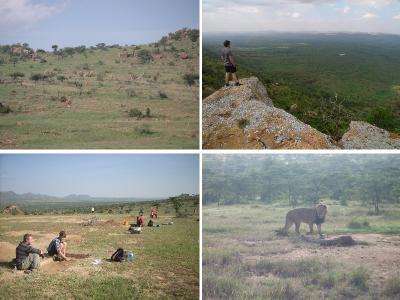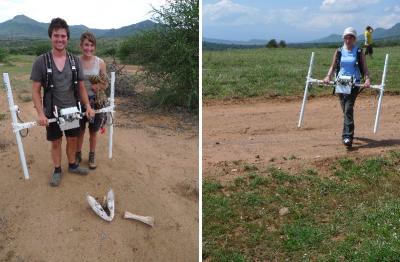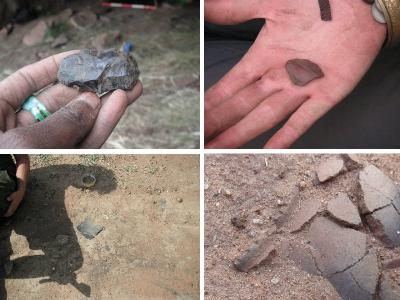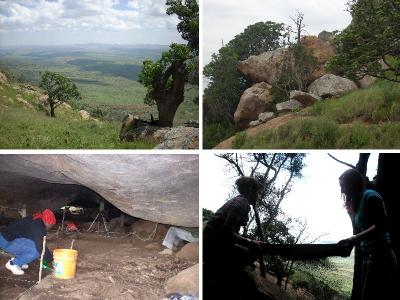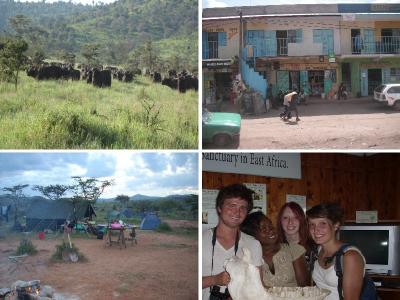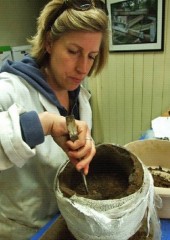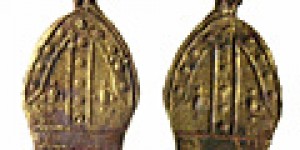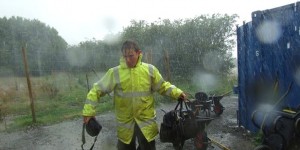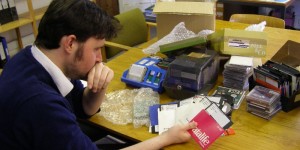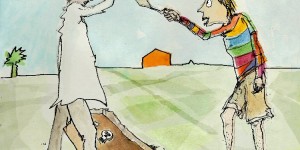In the summer of 2010, a group of University of York Year 1 students (Tom Delany, Hannah Leighton, Khadija McBain, Rachelle Martin, Jacqui Mellows and Matthew Thomas, along with a handful of York support staff) went out to Kenya for a month digging, as part of an opportunity offered by Doctor Paul Lane. Here two of those students, Post Hole staff Khadija and Jacqui, recall their African adventure in conversation with each other.
Site Introduction by Dr. Paul Lane
The rock shelter was mostly Pastoral Neolithic - date range in Kenya about 4500-1200 years ago; this site perhaps in the 4000-3000 time frame to judge from the pottery and stone tools (quite a bit of obsidian - volcanic glass - as I recall, which must have been traded from c. 150km away in the Rift Valley). BUT what were herders doing in a rockshelter? Perhaps these were former hunter-gatherers in the process of adopting the trappings of a pastoralist way of life - not sure how much domestic fauna as opposed to wild fauna there was in the assemblage.
The open site - Mili Sita (Six Mile in English) is much later in date, probably occupied around 1700-1750 AD; large open air settlement, with rubbish dumps, fauna dominated by domestic animals - sheep, goat, cattle - but also some wild; different type of pottery, 'Kisima Ware' may be obtained from neighbouring hunter-gatherers living in the hills some 30km to north; iron making and using. Pastoral Iron Age begins c. 1200 years ago - later societies such as this merge into descendants of modern day pastoralists such as the Maasai - one group of Maasai were moved from this area of land in 1912-14, by the British settler government in Kenya and area set aside for White settlement and farms. Kenya is still living with the legacy of that land move today.
Kenya Memories
Khadija McBain - How did you end up on an excavation in Kenya?
Jacqui Mellows - I absolutely loved the summer term's excavation in first year and decided that I wanted to spend my summer holidays excavating elsewhere. A couple of friends mentioned the Kenya dig to me and I got in touch with Paul to find out more. Having an opportunity as a first year to dig in such an archaeologically renowned location was just too good to pass up. Kenyan archaeology is known for its impact on the study of human evolution, and although we would not be digging on a site quite so ancient, the idea of being so close to where it all began was quite exciting.
KMc - How did you find camping on a Kenyan 'ranch'?
JM - Well, as this was my first time camping ever, I had no idea what to expect. To be honest, initially it was a bit terrifying having absolutely no protection from the Kenyan wildlife, especially as we could hear the lions every night. But by the end, sleeping with the sound of the bugs and the frogs at night was extremely peaceful. Going back to Nairobi and the sounds of traffic made it impossible to sleep!
JM - Did the 'ranch' have many archaeological hot spots that you did not get to excavate?
KMc - Yeah, it had quite a few that we did not get to excavate — Paul showed us a few places near to where we were camping that had archaeology and also an iron smelting area where we found bits of iron slag.
JM - Did you do any geophysical surveying? What was this like in Kenya?
KMc - I got to do topographical surveying which required us to set up our tripod and survey Mili Sita while hoping we did not run into any animals in the process or that they did not knock over the tripod. I really enjoyed the surveying and we got to see our results later that night when Ben (Gourley, York research student) entered the data onto his laptop. It was good to see the whole area and the parts that we were excavating.
JM - What kinds of features did you find in your trenches?
KMc - Features, I love that word! In the trench I was excavating, we thought we found a wall as there was a cluster of stones that looked deliberate, but after a while Paul did not think it was, but we planned it and continued with the rest of our trench.
KMc - Were there many surface finds?
JM - There were finds literally all over the place! Just walking through camp you would see bits of pottery and obsidian lying around. I did some field walking on Mili Sita and everywhere you stepped there was surface archaeology. On one particular day, I sat on the side of the road to excavate a broken pot. It was just on the road, left there for hundreds of years. It was completely different to the site at Heslington East.
JM - What were your thoughts when you first arrived on site?
KMc - "Oh my god I am going to be camping in the open", and likewise, I had never camped before so it was an eye opener. But what made the camping 'experience' was not only hearing the lions roaring every night, but waking up in the morning and leaving the tent and the first thing we would see in the horizon was a herd of giraffes or elephants made a first time camper very happy!
KMc - Do you remember your first day of work?
JM - On our first day, and for most of the first week, we drove an hour away from camp up to a rock shelter with the most fantastic views. Getting down to it was a bit scary, especially on the first day when we had no idea where we were going. The cave was so much colder and darker than out on the main site. We were taught how to excavate a trench in spits of 5-10cm with the roof of the cave only a metre above. This called for some serious back breaking work and being very conscious of the proximity of your head to the ceiling! Definitely an experience! The first trench was near the front of the cave mouth and was already under way by the time I started working. Once we had dug for a couple of days, the trenches were deep enough to sit in without banging your head on the ceiling. A second trench was started further back and to see what we were doing we had to hook up some lamps to a generator as it was so dark! The soil was also much looser deeper in, making excavation much easier. We found an array of animal bone, small sherds of pottery and tiny obsidian flakes from tool making. I also did some surveying around the cave to plot the surrounding features onto GPS. This required us to climb around the edges of the cave on the cliff face and also on top which literally felt like the top of the world!
JM - Was the archaeology anything like what you were expecting?
KMc - No not really, because we had only experienced Heslington East and that was a different time period so it was really nice and surprising to excavate an African Neolithic rock shelter and find obsidian lithics. Excavating in a rock shelter with a massive drop where sieving was taking place is not for the faint hearted, and also, like you said, our entry into the cave where we hand to climb down into a grassy bank and enter from the front of the cliff was exciting (is that the right word?!) especially when it rained and the ledge was a bit slippery. One false move and we would have been at the bottom.
JM - How different was it digging on Mili Sita compared to Heslington East and the rock shelter?
KMc - Compared to the rock shelter very different, because we did not have to watch out step in case we fell off the edge of the cliff, but compared to Heslington East not too different as it was an open air trench, but rather than a group working in the trench it was two people. The archaeology was different as we were not finding much pottery but instead finding lots of animal bone, especially zebra, and the soil was much harder from the sun and made digging quite tough. But again, the view while we were digging on Mili Sita was completely different to anything as we would see zebra, elephants, giraffes, baboons, impalas - so many. I say it so casually but people pay to go on safari to see these animals and they were part of our everyday life whilst on excavation.
KMc - What did you find in what was dubbed "the bone trench"?
JM - The bone trench was just down the road from the main focus of trenches, but the soil was much, much looser and very easy to dig. Again, we dug in spits of 5-10cm and each layer produced hundreds of pieces of bone, from small fragments to, in one instance, a partial goat or sheep's skull! There were also a number of large charcoal areas in most layers. This trench was much deeper than the others on Mili Sita and took a number of us working until dark on the last day to get to the bottom, where the stratigraphy and section drawings were very interesting.
KMc - How would you describe the day buffalos decided to visit us while we were excavating?
JM - Absolutely terrifying!! Before I went to Kenya, I had never realised how scary buffalo are. I had always figured lions or elephants would be the ones to watch out for. I remember most of us were happily digging away like any other working day, when Tom, Paul and Ben shouted down from the opposite hill that there were buffalo in the dip just next to us. Sure enough there was a herd of nearly 100 buffalo extremely close to where we were working. Paul told us to literally drop everything and pile into the only vehicle we had. This meant that Matthew, Rachelle and I were clinging to the spare wheel on the back to prevent us falling off as we speedily drove away. I remember the car stopping briefly not far from the herd of buffalo so people could take pictures from inside the vehicle; however the three of us out in the open were more than a little scared as we got a bit closer for a photo opportunity. We did then get an extra hour off work while the buffalo invaded our site, which was nice. They had completely gone by the time we returned. Talk about close encounters!
JM - How did you enjoy our days off?
KMc - I loved days off, especially when we went into the nearest town, Nanyuki and just chilled. There was a really, really, really lovely patisserie place that did the nicest milkshakes in the world. I still think about them now. I remember when Hannah and I first had one and all we thought about while excavating was going back to the patisserie and buying another one. But we did enjoy our days off especially seeing the town and people.
JM - What was the day out at Sweetwaters nature reserve like and how was it different from 'our' ranch?
KMc - I enjoyed Sweetwaters nature reserve, and the fact that Paul had the time to take us out to the reserve during our day off. The landscape was completely different to where we had been staying and digging, and was much grassier like you would have expected the Kenyan savannah to be. The best bit of the whole trip was spotting the lioness and her cubs - when we were driving along and having to reverse to get a better look. Some of us (aka Tom Delany) got a better look by poking his head out the window trying to entice the cubs closer to the van. We also visited both white and black rhinoceroses that were being protected from poachers and were also able to stroke and feed one blind black rhino, which was particularly incredible. I will be honest though as I went to approach it I did have a vision of it biting my whole arm off! The visit to the mini museum was fun as we got to 'play' with artefacts such as gazelle horn cores, rhino skulls and leopard skins.
KMc - How did you find camp life?
JM - Camp life had a real buzz. All the tents surrounded the main camp fire and social area, with the kitchen tent in the middle. At the end of a day's work we would sit around the fire and get to know each other, especially those who were not from York. Dinner was served around 8pm every night once the weather got a bit cooler and despite the conditions, the food was really tasty. Obviously there was a limit to the amount of fresh food that could be kept in the heat, but Francis the cook did an excellent job. Afterwards, we took it in turns to wash up. Personal washing was a whole other issue! Hot water had to be heated in a washing up bowl over the fire which usually meant it got far too hot. The "shower" was a watering can behind a very precarious bamboo sheet just outside of camp which never felt like it hid any modesty. But we were all in the same boat so we could laugh about it.
KMc - Do you think we had a good group dynamic overall in camp?
JM - I think we all got on really well. The Kenyan and Tanzanians that we worked with had so much more experience with this type of archaeology and environment and it was amazing to learn new things from them. Additionally, I do not think I have ever or will ever meet a group of such eccentric people in my life!
KMc - Especially when some of the Kenyan students asked the most awkward questions in the world!
KMc - How did the safari drives looking for the lions at night compare with seeing the lion during our drive to work?
JM - The safari drives were always so exciting. A few times we went out at night after hearing the lions roaring hoping to find them close to camp. However, we never saw them at night despite how close they sounded. But we were never disappointed, catching glimpses of hyena, bush babies, zebra and elephants most nights. So when we finally spotted a lioness and cubs at Sweetwaters I can safely say we were all very excited. We watched the cubs playing in the bushes and trying to build up courage to get closer to the vehicle for ages! However, the following morning on the drive between camp and site we saw two young male lions about 300 metres from the camp site! Seeing lions in the nature reserve was one thing, but also seeing the wild lions where we had been living for three weeks was incredible! I do not even think I was scared or worried about their proximity!
JM - From the archaeology and the animals overall, what was your all-time favourite moment in Kenya?
KMc - Using different excavation methods and working on two different time periods of sites, and also excavating with the Kenyan and Tanzanian students and talking about our different perspectives while excavating was so interesting and exciting. But who can forget the morning we saw the lions on the way to work, and then working in the same proximity asking the valid question to the Kenyan students: "what do we do if the lions come back"?!
JM - For me, excavating in Kenya was the most amazing experience, not just because of the camping and all the wildlife we saw, but because the archaeology was so different from anything in the UK. Being involved in a dig in Africa, finding so many artefacts lying in the road, and excavating a rock shelter are things that not every archaeological student will be able to say they have done. I think it is safe to say that all of us from York thoroughly appreciated and enjoyed this opportunity, and it will be one of the most memorable things we have ever done.


